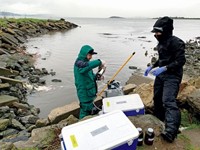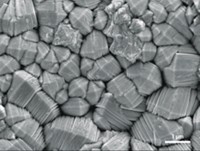Advertisement
Grab your lab coat. Let's get started
Welcome!
Welcome!
Create an account below to get 6 C&EN articles per month, receive newsletters and more - all free.
It seems this is your first time logging in online. Please enter the following information to continue.
As an ACS member you automatically get access to this site. All we need is few more details to create your reading experience.
Not you? Sign in with a different account.
Not you? Sign in with a different account.
ERROR 1
ERROR 1
ERROR 2
ERROR 2
ERROR 2
ERROR 2
ERROR 2
Password and Confirm password must match.
If you have an ACS member number, please enter it here so we can link this account to your membership. (optional)
ERROR 2
ACS values your privacy. By submitting your information, you are gaining access to C&EN and subscribing to our weekly newsletter. We use the information you provide to make your reading experience better, and we will never sell your data to third party members.
Environment
Today's Materials Favor Mold Growth
Dampness brings mold in; volatile compounds, ergosterol, and a glucan reveal its presence
by LOUISA WRAY DALTON, C&EN WASHINGTON
February 16, 2004
| A version of this story appeared in
Volume 82, Issue 7
Water damage is intrinsically tied to indoor mold growth. And how buildings are constructed today contributes to the potential for damp spaces, says James Holland, a director of the Indoor Environmental Institute, a not-for-profit corporation in Sacramento, Calif. The energy crisis of the 1970s, Holland explains, led to a surge of energy-efficient building construction. And energy-efficient homes, he adds, have less natural ventilation and "reduced drying potential."
"Buildings need to breathe," says Linda Stetzenbach, director of the microbiology division at the Harry Reid Center for Environmental Studies at the University of Nevada, Las Vegas. "Moisture will come into a building, and buildings need to give off that excess moisture. But if you are using a product that traps the moisture either in the building envelope or in the rooms themselves, that moisture will soak in and lead to mold growth. Very few buildings anymore have natural ventilation where you can open a window and let out the moisture. The windows are sealed more tightly, and moisture gets trapped inside the buildings."
In addition, building materials have changed. Builders are using more recycled materials, which are often a composite mix of wood fibers held together with adhesives. Mold grows easily on the adhesives as well as on the wood fibers (cellulose) that have been broken down and are not protected by intact cell walls as they would be in solid lumber, according to Joseph Lstiburek, a principal engineer at Building Science Corp., Boston, and an expert on moisture-related building problems. Damp particle board, waferboard, medium-density fiberboard, and paper-covered gypsum board are especially welcome homes for fungi, which use cellulose as their primary carbon source.
Lstiburek writes about how leaky windows were not such a problem more than 100 years ago. Back then, windows were more likely to be framed by heavy timber that was sheathed on the interior with plaster on metal. These materials resisted mold growth because they would dry out.
Stetzenbach lists a myriad of building and engineering defects that also lead to moisture retention in buildings, from a net negatively air pressured air-conditioning system that sucks moisture in through the foundation to insulation that faces the wrong way.
"And maintenance issues are a real problem," Stetzenbach says. "This happens in school districts where money is tight, and people want it to go straight to education or administration. Things that don't seem to be a big problem at first, like a slow leak, can result in a major problem later."
AFTER ONE or more mold species take up residence indoors, they make their presence known. The human nose is often the first and best detector of new mold growth. All growing fungi release an unmistakable musty, earthy odor: a blend of microbial volatile organic compounds (MVOCs). These are secondary metabolites, molecules that are produced by a fungus after it uses up one or more of its nutrients. Like mycotoxins, MVOCs help keep competing fungi and bacteria at bay. MVOCs also help attract insects that can transport fungal spores to a new food source.
All fungal species release a different profile of MVOCs, and that profile changes depending on what the fungus is eating at the time. Generally, MVOCs are a blend of alcohols, ketones, and other small molecules. Geosmin, a bicyclic alcohol that has a strong musty odor, is a common component. MVOCs, however, are only released while the mold is still living. Long after a mold is dormant or dead, it will continue to release spores, pieces of mycelium (the mass of threadlike hyphae), and cell fragments.
Scientists detect the presence of indoor mold contamination primarily by capturing airborne or surface spores and culturing them or examining them under a microscope. Mold spores are ubiquitous in both indoor and outdoor air. But when there is rapid mold growth or amplification, there is a change in fungal ecology and the population of airborne spores and floating cell fragments shifts. "Usually in a building that is not a problem building, no one species dominates," Stetzenbach says. "It's a mixed population of organisms, and the numbers are fairly constant. When you have a water accumulation problem, the numbers will increase by orders of magnitude and the populations will shift. Some of these fungi become the dominant organism." Some laboratories also are beginning to use genetic testing methods--specifically, polymerase chain reaction--to amplify the DNA from a spore or mold fragment to identify fungal populations.
Two nonspecific indications of mold growth or biomass are an increased presence of ergosterol or -1,3-D-glucan. Ergosterol is a building block of fungal cell membranes. Testing for it "is valuable because nothing in a terrestrial environment accumulates ergosterol," Miller says. "If you find it, it means that there is fungal material there for sure." Ergosterol can be detected by sampling and gas chromatography-mass spectrometry analysis.
 --1,3-D-Glucan is part of the fungal cell wall and is itself a biologically active inflammatory compound. Testing for the glucan requires an antibody test. These tests are useful in laboratory research. But for mold cleanup and remediation, some experts don't recommend testing for mold biomass or even identifying the mold.
--1,3-D-Glucan is part of the fungal cell wall and is itself a biologically active inflammatory compound. Testing for the glucan requires an antibody test. These tests are useful in laboratory research. But for mold cleanup and remediation, some experts don't recommend testing for mold biomass or even identifying the mold.
"When people find a mold in an indoor environment, what we recommend is that they take steps to remove that mold," says Stephen Redd, chief of the Air Pollution & Respiratory Health Branch of the National Center for Environmental Health at the Centers for Disease Control & Prevention. Removal, he explains, includes "identifying and removing the water source and removing the contaminated building material. We don't recommend culturing mold routinely because it doesn't really inform. It's not helpful in guiding the response. We're not able to say, 'Oh, you have this kind of mold. That means you are at risk.' "
When getting rid of mold, "the focus is on old-fashioned moisture control and cleaning," says Eugene C. Cole, a professor of environmental health and infectious disease at Brigham Young University. He has helped develop a new standard for cleaning of indoor mold, called the IICRC S520 Standard & Reference Guide for Professional Mold Remediation. Cole emphasizes that mold remediation doesn't require potent antimicrobial chemicals, and he doesn't recommend applying preventive antimicrobial coatings to surfaces. "Antimicrobials work by direct contact. Once you have a layer of dust, the effect is gone. To make them effective, you have to have a regular program of cleaning and maintenance. And if you have a regular program of cleaning and maintenance, you don't really need the antimicrobial coating or paint to begin with."
MORE ON THIS STORY
- - HOW DANGEROUS IS INDOOR MOLD? Evidence continues to accumulate that mold can cause illness, but the degree of hazard is unclear
- - MEDICAL ANNALS Infamous Stachybotrys Brought Indoor Mold Into The Public Eye
- - TODAY'S MATERIALS FAVOR MOLD GROWTH Dampness brings mold in; volatile compounds, ergosterol, and a glucan reveal its presence








Join the conversation
Contact the reporter
Submit a Letter to the Editor for publication
Engage with us on Twitter